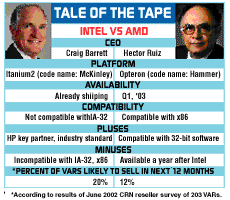Linus Leans On Intel
In remarks to other Linux developers, as well as in an e-mail, the inventor of Linux has begun publicly cheering for Intel rival Advanced Micro Devices to achieve success with its own 64-bit desktop platform, in hopes Intel would be forced to follow suit.
"The part I dislike about Intel's strategy is it doesn't have 64 bits on the desktop and thus doesn't have a 'unified' story," Torvalds said, adding that the desktop performance of Intel's 64-bit Itanium processor is "horrible."


An Intel spokesman said the Santa Clara, Calif.-based company is focusing on improving desktop performance by working on technologies, including USB 2.0, hyperthreading and wireless functionality.
The spokesman said the company does not yet see a need for "64-bit addressability" on the desktop.
For several months, Intel has been rumored to be working on a project, reportedly code-named Yamhill, that would provide both 32- and 64-bit software compatibility on a single processor,just as AMD does with its technology.
The Intel spokesman would neither confirm nor deny any such project, saying the company would not discuss such speculation.
Torvalds, who is still the chief maintainer of the open-source Linux operating system, also currently works as a developer for upstart chip maker Transmeta, which counts both Intel and AMD as rivals.

Tim Writer, CTO at Starnix, a Toronto-based solution provider that builds Linux desktop solutions, said that irrespective of the 64-bit question, Linux on the desktop has gained new momentum with Microsoft's new enterprise licensing strategy and the availability of Sun's updated open-source desktop productivity suite. "Today, do I see a real need for 64-bit on the desktop? No," he said. "But did anybody a few years ago see the need for 1.6GHz on the desktop?"
Added Writer, "Linus has proven himself to be a little bit of a visionary, so he's probably right."
Intel's current strategy includes several platforms, including a 32-bit road map for the desktop,currently led by its Pentium 4 product line,and a server strategy that calls for 32-bit Xeon and 64-bit Itanium and Itanium 2 processors.
AMD is set to release its first 64-bit Athlon processors,which also support 32-bit applications,for the desktop late this year. The vendor is expected to unveil its 64-bit Opteron processors for the server early next year. Both processors were developed under the code-name Hammer.
"Having two competing architectures is a stupid thing to have," Torvalds said. "That's why I like AMD's strategy much better: Bring 64 bits to the desktop and allow it to grow up. We've seen how the desktop can grow upward,[the x86 platform is obviously in itself the best example of that.
"But I have never seen a server chip grown downward toward the desktop," Torvalds said. "It's so fundamentally against the server-chip selling model . . . so I don't see Intel being able to unify behind one architecture with IA-64 [Itanium."
Indeed, both Intel and AMD may find migrating installed bases from 32- to 64-bit architecture slow-going. In CRN's monthly solution provider survey in June, only 20 percent of respondents said they had any plans to sell solutions based on Intel's Itanium platform over the next 12 months. Only 12 percent of those responding said they had any plans to sell AMD-based Hammer solutions over the next 12 months.